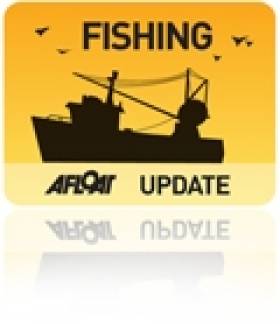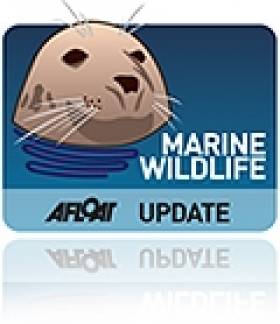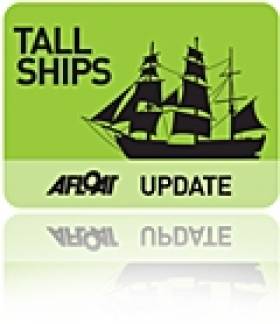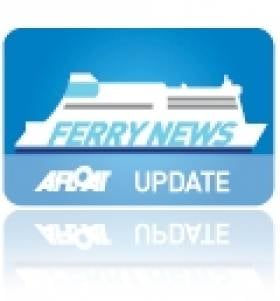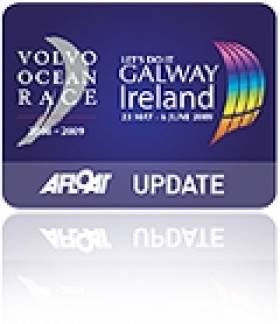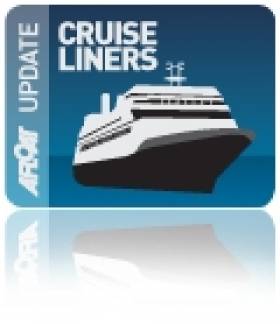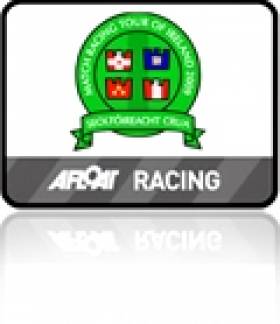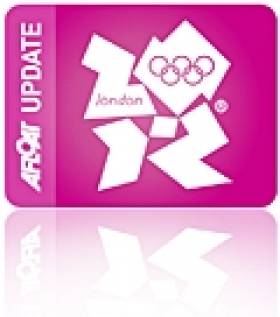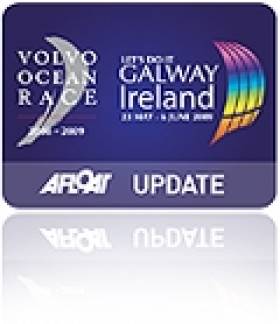Displaying items by tag: Dublin
Damanaki Promises 'Level Playing Field' in Common Fisheries Policy Review
The European Union's maritime affairs commissioner has promised a "level playing field" during the review of the Common Fisheries Policy (CFP), The Irish Times reports.
As previously reported on Afloat.ie, Maria Damanaki was in Dublin on Thursday to discuss reform of the policy with Irish stakeholders.
She admitted that Ireland had suffered under the current policy, which has led to overfishing in Irish waters by other EU member states such as Spain.
The commissioner said that better maritime planning and protection of "small-scale fisheries" were fundamental to the new CFP.
But she denied that Ireland's situation would worsen under the new proposals, which include concessions on transferable quotas that critics - including Minister for the Marine Simon Coveney - fear would see multinationals buying up Irish fishing rights.
She said similar concessions had worked in Denmark, the US, Australia and New Zealand, adding that the system is designed to compensate those who want to leave fishing without straining the EU's finances.
Damanaki also discussed encouraging the development of offshore aquaculture to combat rising imports of seafood, and her commitment to ending the practice of fish discards - which may also involve a programme to provide lower-income individuals with cheaper fish.
The Irish Times has more on the story HERE.
IWDG 21st Anniversary Banquet in November
The Irish Whale and Dolphin Group (IWDG) will celebrate its 21st anniversary at a special banquet on Saturday 19 November at the Grand Hotel in Malahide, Co Dublin.
The evening will consist of a three-course meal and entertainment including music and dancing, a film show of IWDG activities over the years, an international guest speaker (to be announced) exploring the impact of the IWDG on cetacean recording.
The marine wildlife conservation group's AGM will take place earlier in the day at the Grand Hotel at 2pm.
Tickets for the banquet are €60 - book early as places are limited to 120. To book contact Shay Fennelly at [email protected] or 087 642 8902.
Overnight accommodation is also available at the Grand Hotel with special rates for banquet guests of €90 for a single room and €110 for a double/twin room. To book contact Hilary Fogarty, quoting IWDG as the reference, at 01 845 0000, 01 816 8281 or [email protected].
Tenacious Pays a Visit to Dublin
The British Tall Ship Tenacious that sheltered from the storm force winds in Dun Laoghaire at the weekened is in Dublin Port until later today. The Tenacious is one of two Tall Ships in the world designed to offer people of all abilities the opportunity to become a sail trainee. Its sister ship The Lord Nelson is the first Class A vessel to sign up for the final leg of The Tall Ships Races 2012 from La Coruna to Dublin.
Dublin will become the final port of call for The Tall Ships Races 2012 presented by Szczecin and organised by Sail Training International, a charity established to harness sail training to develop and educate young people, regardless of nationality, culture, religion, gender or social background.
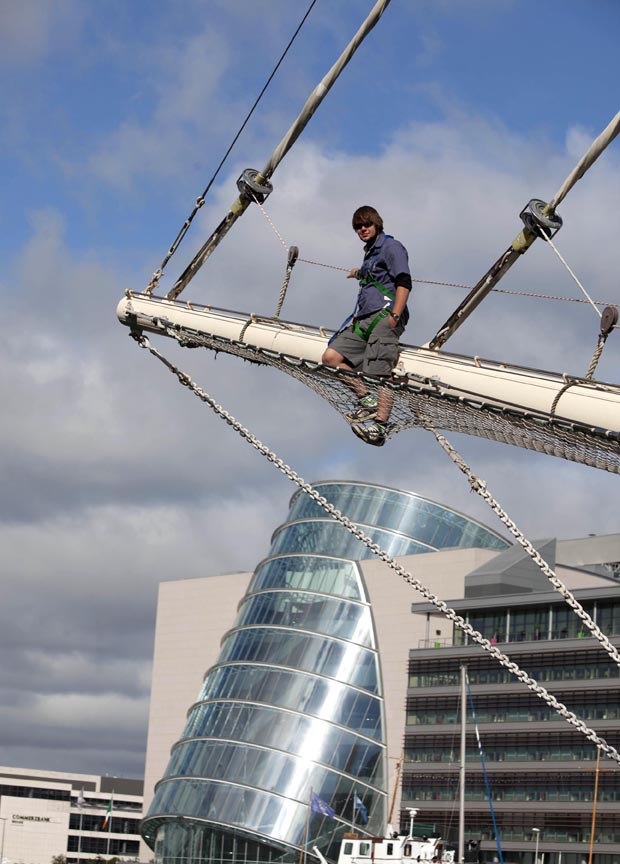
On the bow - Stuart Sheldon, Bosun’s Mate of the British Tall Ship the Tenacious, is pictured carrying out checks as the ship is docked on Sir John Rodgerson’s Quay Dublin. Photo: Andreas/Poveda/Jason Clarke Photography
Expected Strong Winds Lead to Ferry Cancellations
Storm force winds are expected across the country later on this evening and into tomorrow.
Met Éireann has warned of gale to storm force winds tonight with speeds of up to 130km/h, strongest in the northwest.
Extremely high waves are expected on southwest, west and north coasts.
Irish Ferries has cancelled a number of its Swift sailings between Dublin and Holyhead because of forecasts for the Irish Sea.
P&O's scheduled sailings between Larne and Cairnryan this afternoon have been cancelled, as have this evening's sailings between Larne and Troon.
Italian Victory, Ireland Fourth at Star European Championships
Another first place in the penultimate race for Italians Diego Negri and Enrico Voltolini sealed their series-long domination and overall victory at the Star European Championship (2nd-10th September) at Dun Laoghaire yesterday. Irish Olympic campaigners Peter O'Leary and Dvid Burrows finished an impressive fourth overall in the 27-boat fleet.
Photos on the Afloat Gallery by Gareth Craig HERE.
Light and shifty conditions followed by a sea breeze completed the regatta that delivered a full range of conditions for the 27-boat fleet from 18 nations.
Negri and Voltolini kept their form for a fourth race win and typically enjoyed a comfortable lead at the finish of race seven. For the crews chasing the runner-up podium positions, the breeze proved as challenging as it has been all week, this time dying to a near calm on the final run before filling gently on the left hand-side side of the course catching the unwary, notably Guillaume Florent and Pascal Rambeau who had been vying with the Italian leaders for first place.
A wait followed for the eighth and final race of the week but only after a long wait for the sea breeze to build and settle. This took the fleet away from the now familiar area off Dun Laoghaire's West Pier and southwards towards this historic Dalkey Island side of Dublin Bay. After starting in ideal conditions of 18 knots, halfway through the race the breeze died completely to be followed by a 90-degree wind-shift that saw 2008 World Champion Mateusz Kusznierewicz and Dominik Zycki emerge with a substantial lead on the water and, having led from the outset were confirmed as second overall runners-up. Negri and Voltolini had already retired as their position was no better than their already discarded eighth in race six and were busy packing their boat as the final ended.
Irish hopes of a podium result on home waters were denied to London 2012 Olympic contenders Peter O'Leary and David Burrows who placed fourth in the last race but a ninth earlier in the day left them fourth overall as Canada's Richard Clarke and Tyler Bjorn took third place.
Star European Championship 2011 at Royal St. George YC, Dun Laoghaire, Ireland
(Final overall after eight races):
1st ITA Diego Negri & Enrico Voltolini
2nd POL Mateusz Kusznierewicz & Dominik Zycki
3rd CAN Richard Clarke & Tyler Bjorn
4th IRL Peter O'Leary & David Burrow
5th NOR Eivind Melleby & Petter Morland Pedersen
6th POR Afonso Domingos & Frederico Melo
Dublin to Hamble in 24 Hours - Team Sanya's Video
One minute it's trips round the bay with Miss World, canapés at the Royal Irish Yacht Club and corporate hobnobbing in Dun Laoghaire. The next it's a wet and windy ride from Dublin to Hamble in 24 hours. It's the lot of the modern Volvo Ocean Race crew (helmets compulsory). Chinese-Irish race entry Team Sanya boss Mike Sanderson (a previous race winner) has called his exit from Dublin 'heinous'. Don't take our word for it tho, check his vid below:
Queen Elizabeth Arrives on Dublin Bay
Team Echo Win Dublin Match Race Event
After a three round robin series organised by Howth Yacht Club, visting Team Echo, from Poole in Dorest, won Dublin's 2011 Match Racing Open. The team made up of Mark Lees, Toby Yeabsley, Mark Yeabsley and Peter Austin convincingly won the Investwise sponsored series, sailed in J80s with 11 wins and one loss.
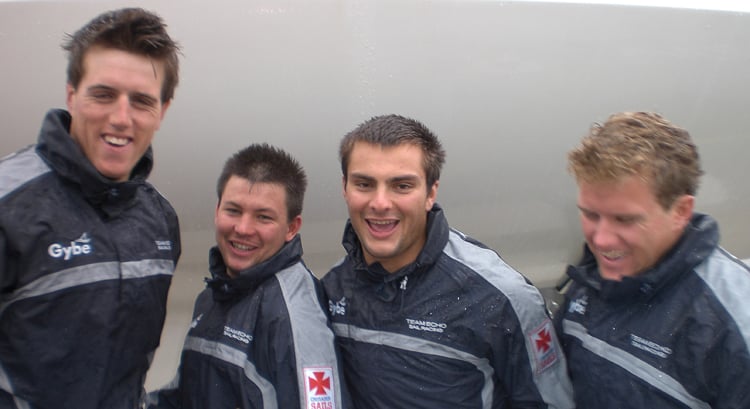
Team Echo won the Dublin Match Racing Open
In the second race an unfortunate incident where bowman Peter Austin cut his leg disrupted the usual momentum of the team. an Irish Match racer kindly stepped in as a substitute for the remainder of racing one the first day and regular mainsheet trimmer Toby Yeabsley stepped in as bowman while Peter went to be treated in hospital.
A tie break was required to split the home clubs team - consisting of evelopment squad members skippered by Ryan Scott - from Peter Bayly and Team PN, with the HYC Development Squad taking second 2 wins to 1. Peter showed glimpses of what he can do, the only skipper to take a race form the British team.
Alistair Kissane and Team Pies finished fourth and Audrey Adamson with SailingWest Ladies finished fifth.

Italians Lead, O'Leary/Burrows Third in Star Europeans
Ireland's Peter O'Leary and David Burrows lie third and only six points off the overall lead held by Italian's Diego Negri and Enrico Voltolini after the first two races of the Star European championships in Dun Laoghaire.
The staging of the Contintental Championship of the Olympic Class, in which Ireland has reasonable aspirations of taking an Olympic medal next year, is being run by the Royal St. George Yacht Club under Howth race officer David Lovegrove.
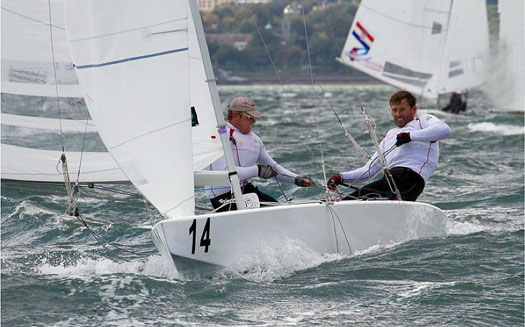
Star racing in big breeze on Dublin Bay yesterday. Photo: Gareth Craig. More pics on the Afloat Gallery here.
Ireland's other entry in the 27-boat fleet, Max Treacy and Anthnoy Shanks, of the host club lie 12th.
Second overall is France's Guillaume Florent and Pascal Rambeau. Britian's double Olympic gold medallists Iain Percy and Andrew Simpson, despite leading the first race for a time this afternoon, have posted an eighth and a seventh to lie eighth overall.
Racing on Dublin Bay continues tomorrow – under the threat of gales – until Friday.
Italians Negri and Voltolini delivered two consistent results of a race win and a second place in the 27-boat fleet from 17 nations.The Italians leaders were the 2006 European champions and overcame challenging post-frontal weather conditions that delivered 20-degree wind-shifts at times on an otherwise smooth race course off Seapoint on the south shore of Dublin Bay.
France's Guillaume Florent and Pascal Rambeau also had a consistent day with a second and third while the home fleet delivered a strong showing as Olympic veterans
Star European Championship 2011 at Royal St. George YC, Dun Laoghaire, Ireland
(Provisional overall standings after two races):
1st ITA Diego Negri & Enrico Voltolini
2nd FRA Guillaume Florent & Pascal Rambeau
3rd IRL Peter O'Leary & David Burrows
4th FRA Xavier Rohart Pierre & Alexis Ponsot
5th CAN Richard Clarke & Tyler Bjorn
6th POR Afonso Domingos & Frederico Melo
Rosanna Davison Goes Back to Her Roots Sailing with Team Sanya
Skipper and past race winner Mike Sanderson and his crew - including Galway's Frankie Leonard - will receive a special send-off from Rosanna who won her Miss World title in the Chinese city of Sanya in 2003.
Team Sanya is the Chinese entry in the 2011-12 Volvo Ocean Race, a 40,000-mile round the world race that will finish in Galway on the 3rd July 2012. A special relationship developed between Ireland and China during the last race through the Green Dragon entry, say backers Discover Ireland, the tourism body.
Rosanna will board the yacht at 11.00am at the Royal Irish Yacht Club and will sail with the team into Dublin Port. The Eastlink bridge will lift at 1.00pm, and Team Sanya will dock beside the Cill Airne at 2.00pm. Rosanna will be on the Cill Airne from 5.30-7.00
As part of the team's promotion and it's Irish link through the Discover Ireland.com brand, the race boat and crew will call into Dun Laoghaire on Sunday, 4th September, at 5pm as previously reported on Afloat.ie.
They will overnight in Dublin and sail up the Liffey on Monday at 1pm and dock beside the MV Cill Airne on North Wall Quay, Dublin 1. A reception will be held on the MV Cill Airne from 5-7pm.
At 7pm the Team will head back out into the open sea as they start their journey to Alicante for the race start on the 5th November.
The Volvo Ocean Race is regarded as sailing's premier global race and one of the most demanding team sports in the world. The 2011-2012 Volvo Ocean Race route is: departing on 5th November from Alicante to Cape Town (South Africa) Abu Dhabi (UAE) Sanya (China) Auckland (New Zealand) Itajai (Brazil) Miami (USA) Lisbon (Portugal) Lorient (Framce) and finally Galway on the 3rd July 2012.
Mike Sanderson, skipper and CEO of Team Sanya commented on the forthcoming trip: "Our relationship with Ireland is really important to us. Frankie Leonard from Galway is our media crew member and he is going to be paramount in telling our story as we race around the world, building the profile of Ireland as the stunning tourist destination that it is. For many of our team, it is our first time visiting Ireland so we were really happy to include a pitstop in Dublin during one of our training trips."
Frankie Leonard, Team Sanya race team and the Irish Media Crew Member, added: "As the only Irishman on board I'm very proud to be part of this exciting event with Team Sanya and really looking forward to sailing into Dublin next week. My home town is Galway and finishing there in July 2012 is going to be a very special moment but this stop-over is a perfect way to help build a strong following and fan base in Ireland to develop Ireland's profile as we travel to nine other ports around the world."


























